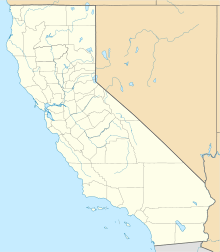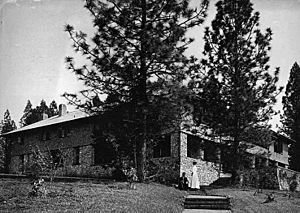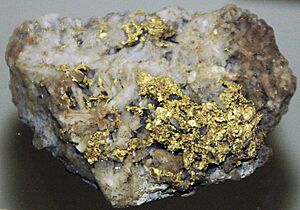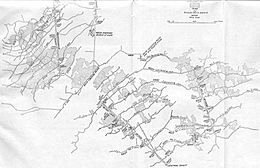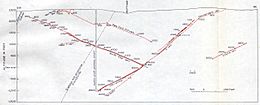North Star Mine and Powerhouse facts for kids
| Location | |
|---|---|
| Location | South end of Mill Street at Allison Ranch Road, on Lafayette Hill |
| State | California |
| Country | United States |
| Coordinates | 39°11′39″N 121°04′35″W / 39.194167°N 121.076389°W |
| Production | |
| Products | Gold |
| History | |
| Opened | 1851 |
| Closed | 1956 |
| Owner | |
| Company | City of Grass Valley |
The North Star Mine and Powerhouse are important historical sites near Grass Valley in California, USA. This mine was the second biggest gold producer during the exciting California Gold Rush. It's famous for having the largest Pelton wheel of its time, built in 1898. The North Star Mine eventually closed down during World War II after it joined with the nearby Empire Mine.
Contents
Where is the North Star Mine?
The North Star Mine is located near Wolf Creek. It's about 1 mile west of the Empire Mine. The whole area is about 65 acres, which is like 50 football fields! The mine sits on a hill called Lafayette Hill.
A Golden History
The "North Star vein," a rich gold deposit, was found in 1851. It was discovered by the Lavance Brothers and other French miners. Over the years, the mine changed owners several times. In 1861, it became the North Star Quartz Mining Co.
The mine closed in 1875 after digging down 1,200 feet. But it didn't stay closed for long! In 1884, William Bowers Bourn II reopened it. Later, James Duncan Hague took over in 1887. He made the company even bigger by buying other mines nearby.
Deep Digging and Power Needs
In the 1850s, a state geologist said the Lafayette Hill area was one of the best for gold mining in California. The mines in the Grass Valley Gold District were very competitive. They often opened, closed, and reopened. A big challenge was finding enough power to get the gold out. Many mines, like North Star, used wood to create steam for their engines.
The North Star Mine became the deepest mine in the Grass Valley area. It reached an amazing depth of 4,000 feet!
The Giant Pelton Wheel
In 1895, a smart engineer named Arthur De Wint Foote came to Grass Valley. He was hired to build an electric power plant for the mine. He installed the biggest working Pelton water wheel ever seen at that time! This huge wheel helped power the mine. The building where this wheel was located is now a special historical landmark in California.
In 1905, a famous architect named Julia Morgan designed a mansion for Arthur Foote and his wife. This house, called the North Star House, is now listed as a historic place.
Mine Mergers and Closures
The North Star Mines Company grew even more in 1911. They bought another big mine called the Champion-Providence Mine. Arthur Foote also helped build Foote's Crossing Road in 1913. This road made it easier to transport things between mines.
Arthur Foote's son, Arthur Burling Foote, later became the mine's manager. In 1929, a large company called Newmont Mining Corporation bought both the Empire Mine and the North Star Mine. They combined them into one big company called Empire-Star Mines, Ltd.
During World War II, the US government ordered many mines to shut down. This was because the country needed resources for the war. After the war, it was hard to find skilled miners. This led to parts of the mine closing by 1951. Finally, all mining stopped on July 5, 1956, because of a workers' strike.
The Miners Who Worked There
Many people worked at the North Star Mine. Some of the important leaders included William H. Rodda, John C. Coleman, his brother Edward Coleman, and Arthur De Wint Foote.
Many of the early miners came from Cornwall, England. They had worked in tin mines there, which were not doing well. These Cornish miners brought new ideas and traditions to California. They introduced the "Cornish pump" for moving water and the tasty Cornish pasty (a savory pastry) to the area!
How the Mine Operated
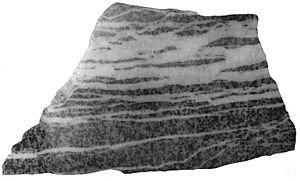
The North Star gold vein ran east and west, slanting down to the north. Miners dug an angled shaft almost 700 feet deep to follow the vein. The vein itself was usually about 2 feet thick, but it could be as thin as a few inches or as thick as 4-5 feet.
Miners used special carts called "tram wagons" to bring the gold ore up the shaft. The rock around the vein was a type of greenstone. The mine also had a vertical shaft for hoisting and ventilation.
Between 1861 and 1865, the mine made about $500,000. A lot of this money was used to improve the mine, like building a long drain tunnel and a new mill with 16 "stamps." Stamps were heavy machines that crushed the gold ore. The mine's owners also received about $375,000 in profits. In 1866 alone, the mine made $315,000 from crushing 6,000 tons of ore!
The gold ore from this mine had a lot of "sulphurets," which are minerals containing sulfur. The mine also found "free gold," which means gold that was not mixed with other minerals.
The Powerhouse and Pelton Wheel Museum
As the mine grew after the Gold Rush, a powerhouse was built. In 1895, it became home to the world's largest water wheel of its kind.
In 1878, an inventor named Lester Pelton created a new type of water wheel. It used special cups to catch water and create power. The North Star Mine decided to use this new "hydraulic power" instead of burning wood. Arthur De Wint Foote designed a huge 30-foot Pelton wheel for the mine. This wheel powered four large air compressors. These compressors sent air pressure deep into the mine's central shaft. Because of his clever design, Foote became the mine's superintendent.
Today, the powerhouse is a museum called the North Star Mine and Powerhouse & Pelton Wheel Museum. The giant Pelton wheel was saved from being scrapped and is now on display. It even turns with the help of an electric motor! The powerhouse is a designated California Historical Landmark. A plaque there explains:
NORTH STAR MINE POWERHOUSE
The North Star Powerhouse, built by A. D. Foote in 1895, was the first complete plant of its kind. Compressed air, generated by Pelton water wheels, furnished power for the entire mine operation. The 30-foot Pelton wheel was the largest in the world, and was in continuous use for over 30 years.
Plaque placed by the State Department of Parks and Recreation in cooperation with the Nevada County Historical Society 15 May 1971.
Gallery
See also


